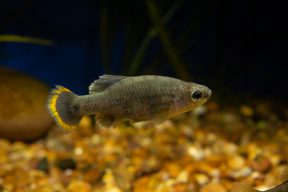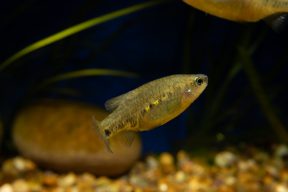Zoogoneticus tequila
Tequila Splitfin
SynonymsTop ↑
Zoogoneticus sp. Lambert, 1990
Etymology
Zoogoneticus: Greek, zoon meaning little animal and the Latin, genesis meaning genesis. presumably in reference to the viviparous nature of the species.
tequila: In reference to the volcano, Volcán de Tequila which is found near the type locality
Classification
Order: Cyprinodontiformes Family: Goodeidae
Distribution
Endemic to the Mexican federal state of Jalisco. It was historically only known from the type locality, the Río Teuchitlán in the Río Ameca headwaters and was thought to be Extinct in the Wild when described. Only one time later, a single male individual was seen at the El Rincón spring in 1999.
Recent reintroduction programmes funded by European zoos and led by the University of Morelia have helped bolster the wild population of this Endangered species.
Historically, Skiffia francesae and Allotoca maculata were found sympatrically with this the Tequila Splitfin, but unfortunately introduced invasives such as Oreochromis spp., Xiphophorus hellerii, Cyrpinus carpio and Pseudoxiphophorus bimaculatus have largely replaced these.
Habitat
Z. tequila can be naturally found in clear, clean freshwater springs, ponds and shallow lagoons. Typically, such bodies of water contain sandy/gravel substrates, rocks and plentiful emergent plant growth such as rushes and reeds.
Maximum Standard Length
Female: 5 cm
Male: 3 cm
As per most other livebearing fish species, females are considerably larger than males in both length and body size. Gravid females may be twice to three times as wide as mature males.
Aquarium SizeTop ↑
An aquarium with base dimension of 90 ∗ 30 ∗ 30 cm should be aimed for. Despite the smaller size of this fish, plenty of space should be afforded for females and subdominant males to escape the libidous pursuits of breeding males.
Maintenance
These fish are unfussy with regards to the decoration of an aquarium, though fine leaved plants may be damaged. Plastic plants and larger, thick stemmed plants are safe and offer a great deal of cover for subdominant fish and fry.
The addition of Moss or artificial spawning mops will offer even better hiding places for fry.
Water Conditions
As the water in which Zoogoneticus tequila inhabits is often quite shallow, the species has developed an excellent tolerance to changing temperatures, though it is best to aim for somewhere in the middle of the range. Many keepers have reported that fish show the best health when given a winter break period where food and temperature is reduced. This slows the metabolism of the fish and relieves pressures of breeding.
The pH should be kept just above neutral with a moderate hardness, although slightly acidic water will be tolerated.
Diet
Conical shaped teeth and a short gut would point to a chiefly carnivorous nature, unlike many other livebearers. In the wild, insect larvae and small aquatic invertebrates make up the majority of the diet, though this fish is not opposed to eating the fry of other species or even its own.
In an aquarium setting, all prepared, live and frozen foods will be taken, but a good quality flake or pellet is recommended for general maintenance.
Behaviour and CompatibilityTop ↑
Quite a nippy species, tankmates are very limited. Small to medium sized Central American cichlids may work well as will larger livebearers suited to similar water conditions.
Avoid significantly smaller or long-finned fish which will become the brunt of abuse.
Sexual Dimorphism
Sexual dimorphism is vast. Males posses a gonopodium like other livebearers, the namesake “splitfin”. This is a specially modified anal fin used as an aid in internal fertilisation. Mature males also show a golden halo around the caudal fin, smaller size and darker overall colour.
Females do not have a gonopodium, show a consistent olivaceous colour over the body and are often much larger than the males, especially when carrying fry.
Reproduction
As with other livebearers, this species carries out internal fertilisation. Spawning occurs above 21 degrees celsius and the gestation period may take up to 50 days.
Females which are ready to give birth are visibly very wide and often take on a square underside profile when days/hours from birthing. Such females should be removed from the main tank and held in a fry trap or release tank to prevent infanticide from other fish in the tank. Once free can be seen, the female should be removed as soon as possible.
In a well planted tank or one with plenty of cover, fry may appear as grown on youngsters occasionally.
Brood sizes may number from 5 up to 30, depending on the age and size of the female.
NotesTop ↑
A single male of the Tequila Splitfin was sampled in 1955 by Miller and Greenbank, but identified erroneously as Zoogoneticus quitzeoensis, with which species it was collected and found sympatrically . Many years later, the mistake was detected, the fish identified as a new species and finally, 43 years after the first capture, described by Webb and Miller.
In 2001, a wild population of this species was rediscovered in a very small spring pool (3 x 4m in diameter). The population there was composed of only a handful of adult fish and a few tens of juveniles (De la Vega-Salazar et al., 2003). In 2007, N. W. Bailey et al showed, that the allelic richness of this population (though it was comparable in size to an aquatic stock) was higher than in any aquatic stock. In 2013 the loss of this population was reported (pers. comm. Domínguez), so there is not much hope that this species is still persisting in the wild.
The Goodeid Working Group, Chester Zoo and other organisations started together with the University of Morelia a reintroduction project for this species (and the critically endangered cyprinid Notropis amecae) in 2015. This project encompasses strategies to get the local residents on board, the using of recreation ponds for the acclimation of captive bred fish, the reintroduction of the fish and a monitoring and scientific guidance over 2 years. The whole project is thought to go over four years and would have been the first reintroduction project done with a Goodeid species. Here can be read the details of the project in 2016
References
- WEBB, S. A. & MILLER, R. R., 1998 - Occasional Papers of the Museum of Zoology University of Michigan Ann Arbor : Pages 1-23
Zoogoneticus tequila, a new goodeid fish (Cyprinodontiformes) from the Ameca drainage of Mexico, and a rediagnosis of the genus - Capuli, Estelita Emily - Fish Base
https://www.fishbase.se/summary/Zoogoneticus-tequila.html - The Goodeid Working Group - http://www.goodeidworkinggroup.com/zoogoneticus-tequila
Zoogoneticus tequila



